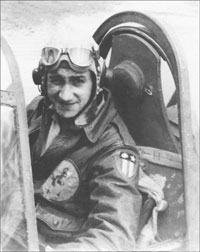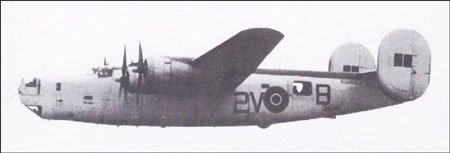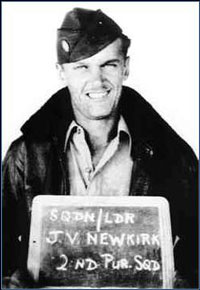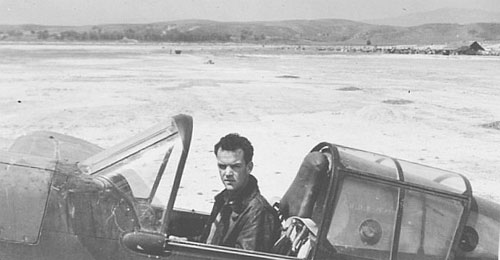 07 Dec 1944: 2LT Thomas Ankrim,1 flying a P-51 in the 25th Fighter Squadron of the 51st Fighter Group out of Yunnanyi, 2 hit a tree on a low altitude strafe during an “offensive road sweep” on the main transport connection between Takaw Ferry, Keng Tung, and Wan Pa-hsa. The P-51 crashed and Ankrim was killed. 3
07 Dec 1944: 2LT Thomas Ankrim,1 flying a P-51 in the 25th Fighter Squadron of the 51st Fighter Group out of Yunnanyi, 2 hit a tree on a low altitude strafe during an “offensive road sweep” on the main transport connection between Takaw Ferry, Keng Tung, and Wan Pa-hsa. The P-51 crashed and Ankrim was killed. 3
The road was targeted as part of a strategy to stop supplies destined for the IJA in Burma which were moving by rail from Bangkok to Lampang where they were then transferred to trucks for traveling north on the Phahonyathin Road to Mae Sai and on into Burma. The target road connected the border crossing Wan Pa-hsa across from Mae Sai to Keng Tung and on to the Takaw River bridge crossing the Salween River, a distance of about 350 km, 4 and all part of current day Myanmar (Burma) Road No 4 leading west to Meiktila.
In a P-51, flight time from Yunnanyi to the target would have taken less than an hour: 5
 No Missing Air Crew Report (MACR) has been found for Ankrim’s loss. There is, however, a report which describes the mission and his loss: 6
No Missing Air Crew Report (MACR) has been found for Ankrim’s loss. There is, however, a report which describes the mission and his loss: 6
 Detail relevant to Ankrim includes:
Detail relevant to Ankrim includes:
(1) 7 December 1944
(2) Four P-51s and four P-38s
(3) Offensive road sweep between Wan Pa-hsa, Kengtung, and Takaw Ferry.
(4) . . .
• P-51s strafed: Steam roller on road one mile north of Wan Pa-hsa, scoring direct hits.
• A group of camouflaged carts near highway.
• One camouflaged truck twelve miles north of
Wan Pa-hsa.
• Truck burned.
• One caterpillar tractor and one truck at Wan Mong-Pong. The tractor caught fire and the truck was heavily damaged.
• One truck two miles northwest of Loi-Mue. Truck destroyed.(6) While making a strafing pass, the right wing of a P-51, piloted by 2nd Lieutenant THOMAS ROGER ANKRIM, hit a tree, caught fire, and the plane crashed. Pilot was killed instantly. . .
Amkrim’s Individual Deceased Personnel File (IDPF) has been maintained and, importantly, it includes approximate coordinates for his crash site: 7
“A/C strafed a steam roller on road 1 mi. N. of Wan Pa Hsa and the right wing struck a tree and crashed at 20°30’N 99°57’E near Thai border”.
But note that the coordinates are only approximations: limiting conditions include:
• N20°30 means a location anywhere between N20°29.5 and N20°30.5; eg, the possible location can be anywhere in a north-south one minute distance of about 1.85 km (1.15 mi); and at this latitude, an east-west one minute range for E99°57 would be about 1.73 km (1.08 mi). That defined area would cover an area of about 3.2 sq km (1.24 sq mi).
• Further it is unclear what datum was being used on Allied pilots’ maps: the standard today, WGS84, did not exist back then, and points might vary in both north-south and east-west distances by several hundred meters between datums.
• And finally, pilots making these location estimates were cruising at 550 km per hr (340 mi per hr), sometimes at treetop level, always alert for the appearance of enemy aircraft and anti-aircraft bursts, while at the same time looking for additional targets.
Under such conditions, accuracy suffered. But suffice to say that Ankrim crashed on the Burmese side of the border, in the vicinity of present-day Tachileik.
Mapped out, the mission looked like this: 8
 Efforts by the American Graves Registration Service immediately after the war to locate his remains are unknown. At present, the Myanmar government limits access to the general area of Ankrim’s crash site, and until that access is regained, there can be no further progress towards location of Ankrim’s crash site and retrieval of his remains.
Efforts by the American Graves Registration Service immediately after the war to locate his remains are unknown. At present, the Myanmar government limits access to the general area of Ankrim’s crash site, and until that access is regained, there can be no further progress towards location of Ankrim’s crash site and retrieval of his remains.
As a consequence, his name remains included in the list of “Missing” in the Manila American Cemetery and Memorial: 9
 His parents long ago erected a stone in his memory in his hometown, Lancaster, Pennsylvania, USA: 10
His parents long ago erected a stone in his memory in his hometown, Lancaster, Pennsylvania, USA: 10
Afterword:
A possible reason for Tachileik, or Tachilek, or Ta Kilek, as Goodden spelt it 11 (and as it is pronounced), not appearing on some Burmese maps lies in the name being the combination of the Thai words, tha and kilek, meaning pier and a tree whose leaves are used in cooking, respectively). 12 Presumably the airport had been named before a possible need to favor Burmese names, with the airport name cast in stone in the network listing for airports worldwide.
References:
Neither Shores nor Umemoto mention this event.
The Thai Air Accidents entry for Ankrim is outdated.
| First published on Internet | ||
- Photo: extracted from Find-a-Grave.[↩]
- Dan Jackson, Fallen Tigers, (Lexington: University Press of Kentucky, 2021), p 173. Old Yunnanyi Airstrip: N25°25.035 E100°42.165[↩]
- P-51 photo: FindaGrave[↩]
- A distance then of 218 miles (350 km) per The Motor Roads of Burma (Rangoon, The Burmah Oil Co, 1948), p 55.[↩]
- Extract from Google Maps, annotated by author with Microsoft Publisher.[↩]
- Mission Number F-1363 of 07 Dec 1944, provided by Dan Jackson email of 1314 22 Sep 2018.[↩]
- Information provided by Terry Hunter email of 0642 08 Jul 2021. The IDPF is held by the Air Force Historical Research Agency (AFHRA) history of the 449th Fighter Squadron.[↩]
- Extract from Google Maps, annotated by author with Microsoft Publisher. For reference, position sources: Wan Mong Pong: N21°04 E100°10 (NF 47-11, Keng Tung, 1959) Loi-Mwe: N21°10.38 E99°45.100 (NF 47-11, Keng Tung, 1959) Takaw Ferry: N21°13.16 E98°42.35 (NF47-10 Lai-Hka, 1959) Coordinates, after points located, taken from Google Earth, where possible. While two places named Wan Pa hsa appear on NF 47-15, Amphoe Mae Chan (1964), only one is near the border, at N20°26.78 E99°52.59; ie, basically in present day Tachileik, across the Mae Sai River from Mae Sai, Thailand.[↩]
- FindaGrave, annotated by author using Microsoft Publisher.[↩]
- Cenotaph at Chestnut Level Presbyterian Cemetery, Quarryville, Lancaster County, Pennsylvania. Annotated by author using Microsoft Publisher.[↩]
- Goodden, Christian, Around Lan-Na (Halesworth: Jungle Books, 1999), p 143[↩]
- Suggested by Wiyada Kantarod, translator / interviewer[↩]








